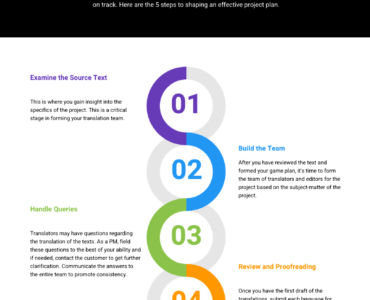by Evgeniya Melnik
Literal translation is an expression that refers to a word-for-word translation that is too close to the original text. This can also be referred to as a linear translation. A literal translation may not sound natural in the language of the intended audience and is often difficult to read. It may also not convey the intended meaning of the source text.
Understanding how to prevent literal translations can improve the general quality and accuracy of a translation. It will also ensure the message that is conveyed by the original text is relayed to the reader in the language of the target.
Here are the main issues with the literal translation:
- Maintaining the same phrasing or even word order of the original text.
- Keeping the exact placement of punctuation marks.
- Not reworking sentences that require it.
- Failing the source text’s meaning by utilizing the same idioms, tenses, and, overall, words of the target language.
You may follow these quick basic steps to avoid direct translation:
- Switch the word order, restructure phrases, and modify sentences.
- Learn the cultural features of the population you will be translating for
- Expand your vocabulary in both the source and target languages
To fundamentally solve the problem of literal translation, you must force yourself to “think only in the language of your choice,” recommends Rosetta, a professional writer from Studybounty. One more piece of advice from her – make sure to do the translation loosely: think about the conveyed message in term of blocks of ideas. Ignore the individual words and concentrate on the essence of the message.
When you finally get to actual translating, be aware of the following aspects to avoid the traps of literal translation.
The Structure of the Language
There are many elements that are different between the various languages. For example, in English, the verbs are placed after subjects and objects. But in the Arabic language, the semantic and structural rules are completely different.
Solution: Limit your Expertise
The only way to overcome the language structure issues is to be aware of the grammatical distinctions between both languages. With this knowledge, it is possible to alter the order of words and phrases to understand the meaning in the language of your target.
Utilize translation tools, grammar checkers, and other methods to ensure that you’ve preserved the structure of the language you want to translate to without altering the essence of the original paper.
Cultural Differences
The way of life and customs practiced by native speakers of each language can be quite different. Frequently, colloquialisms are incorporated into formal languages, causing translation to be highly challenging.
The larger the area of spoken language is, the more dialects are likely to be in the text or speech. The same applies to colloquial terms.
Then the issue emerges in determining the best way to translate the idea precisely without damaging feelings or irritating the audience.
Solution: Conduct Research and Study
Explore the web to discover the most common colloquial expressions in the respective language. Also, learn about the most popular dialects. Get immersed in the local culture and traditions: watch films and TV shows, or read magazines and books.
Homonyms and Homophones
English, along with the Romance languages, is full of different meanings. Homonyms are terms written and spoken similarly but can refer to other things based on the situation. For example, the term “date” could mean a specific day, a particular fruit, or even a date with someone you cherish.
Also, there are homophones. These are terms that sound similar. However, they have different spellings, meanings, and definitions. Examples of homophobes are “bye/by/buy” or “show/shore.”
Solution: Focus your knowledge
Many languages have words with various meanings and heteronyms. Understanding when to use appropriate homonyms in translating content is an issue. To get around this, one must know the language vocabulary of both. This could require the translator to dedicate themselves to studying both languages in depth.
Determine your creative license
In certain types of texts, the translator can and should take the liberty to rework the text to avoid a literal translation. For example: texts in the areas of tourism, music, prose. In these types of texts, the translator has to change things around so that the translation reads well in the target language. And it is inevitable in these cases that the translator makes changes that stray from the language of the original document. In other types of texts, however, the translator is extremely limited in what they can change. This includes legal texts, patents and medical instructions. Changes to these texts, even if minor, may be outside of the translator’s mandate. In each case, the translator should consult with the owner of the content to determine how creative they can get with adjusting the text in order to reach the desired level of fluency.
About the Author

Evgenia Melnik is a content marketing specialist at educational platform StudyCrumb, that helps students all over the world.





